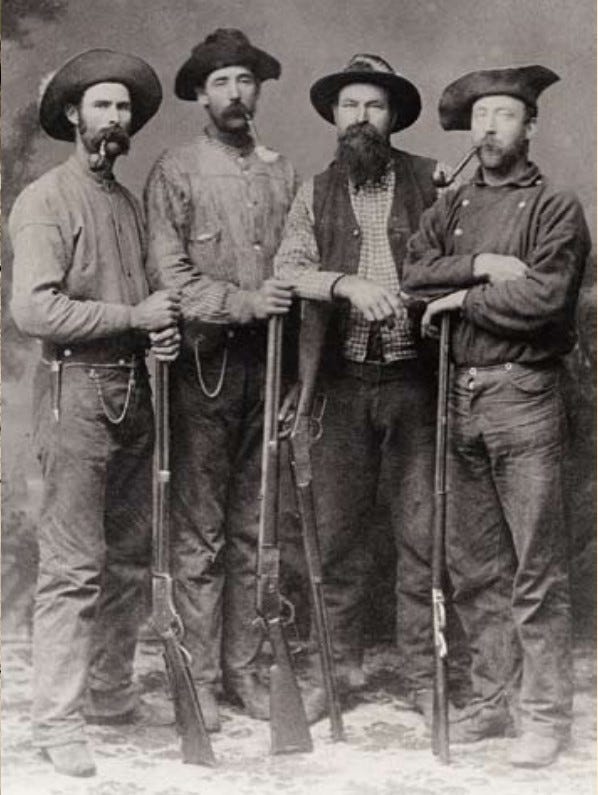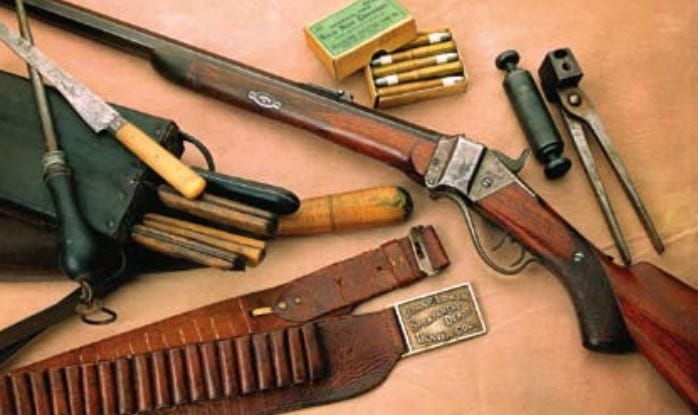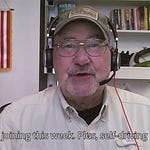I was born 10 years too late. The one I shall refer to as Mr. R lived at the edge of town where Main Street turned into a two-lane highway. Our farm was a quarter-mile further out.
We passed Mr. R’s house every time we drove into town. On the rare occasions I caught sight of him outside, he would smile and wave.
When I was in, say, 5th grade, he must have been in his 80s.
Mr. R was what today we would call a gun nut. A kindly old man, he spent a great deal of time in his detached shop, working on his firearms. I was rarely inside his shop, and I never really spoke to him, but it was clear that he knew who I was.
He would have been born in probably 1880 or 1890. My understanding is that he learned to shoot from what were then known as “market hunters.”
The Market Hunters
In one of the especially robust periods of American growth, from post-Civil War to the early 20th century, the U.S. population tripled, from 25 million to 75 million residents. Demand for fresh meat similarly grew.
The absence of regulation and the abundance of wild game west of the Mississippi gave rise to the market hunter. He was a man who could make a living harvesting game of all types. Meat and hides were both in high demand.
(Photos are from The Market Hunters: Demand, Depletion, Devastation. It is an article worth reading.)

The confluence of population growth, railroads, quality steel, and advances in both firearms and ammunition made market hunting suddenly profitable.
It also nearly doomed hunted species.
As a footnote worthy of mention, the market hunter trade earned a bad reputation, some of it well deserved. Many millions of buffalo were reduced to a total on the continent of less than 1,500 by the turn of the 20th century. Elk and deer herds were decimated.
By the 1960s when I grew up in south central Kansas, the rumor was that a deer — a single deer! — had been spotted along a rural creek. It was big news, owing to their rarity.
Thanks to conservation efforts championed by the likes of William Temple Hornady, George Bird Grinnell and Theodore Roosevelt, wild game populations recovered dramatically. The aforementioned south central Kansas region is now a prized destination for white tail deer hunters. The deer are seemingly thick as rabbits.
Economical morality
To the market hunter of the late 19th century, costs mattered. It was preferable to use a single cartridge or shotgun shell to do the job, rather than waste multiple rounds. Better for the critter, better for the one who dressed the meat, better for the hunter’s expense account.
In that environment, Mr. R learned to shoot straight, harvest the game and sell it at a profit. From what I know of him, there would never have been wanton waste of game. A humane kill — one expertly-placed shot — would have ended the animal’s life quickly with a minimum of pain.
Mr. R’s gentlemanly conduct was not limited to his guns and quarry.
An admirable finish
When I was deemed old enough to ride a bicycle to and from school (a mile away in town), my parents rightly objected to my riding on the highway. However these negotiations came about, Mr. R built a wooden bike rack for me under a shade tree in his front yard.
In the mornings, I would walk the 300 yards to his house, then mount the bike and take it to school. In the afternoon I would retrace the route, park the bicycle in the rack and walk the rest of the way home.
Only years later, after Mr. R’s death, did it occur to me what an act of kindness it had been. What farm kid needs a bike rack under a shade tree, anyway? He can just lay it down in the ditch!
The rack dressed up his front yard and made my humble two-speed look respectable. Now that I approach his age, I realize he and the Mrs. probably looked from the living room window to make sure I was all right, coming and going. It would have gratified them to know their service was a help to an oblivious pre-teen.
Takeaway
I cannot think of a more appropriate portrayal of the Biblical admonition to “clothe yourself with kindness” than this completely unmerited service rendered by Mr. R.
“Therefore, as God’s chosen people, holy and dearly loved, clothe yourselves with compassion, kindness, humility, gentleness and patience.” Colossians 3:12
Kindness is a bonus: It does not have to be shown. It is not without cost. What it requires is:
thinking of the needs of another
putting aside one’s own stress and discomfort
intentionally taking pleasure in the convenience offered to another
Would that we all could find a way to practice such kindness, without merit, reward or acclamation.
Most of what I post is not nearly this drippy. Subscribe below, and read the more rough-cut stuff. Thanks for following!

















Share this post